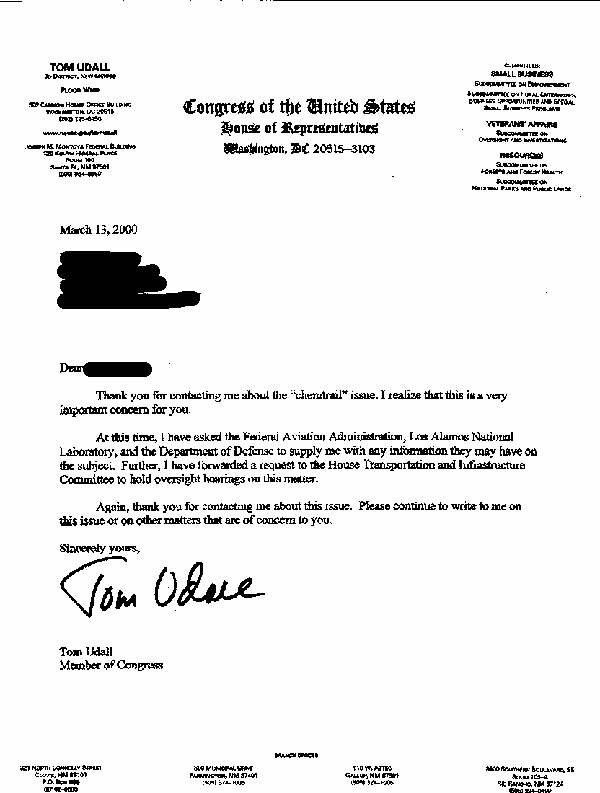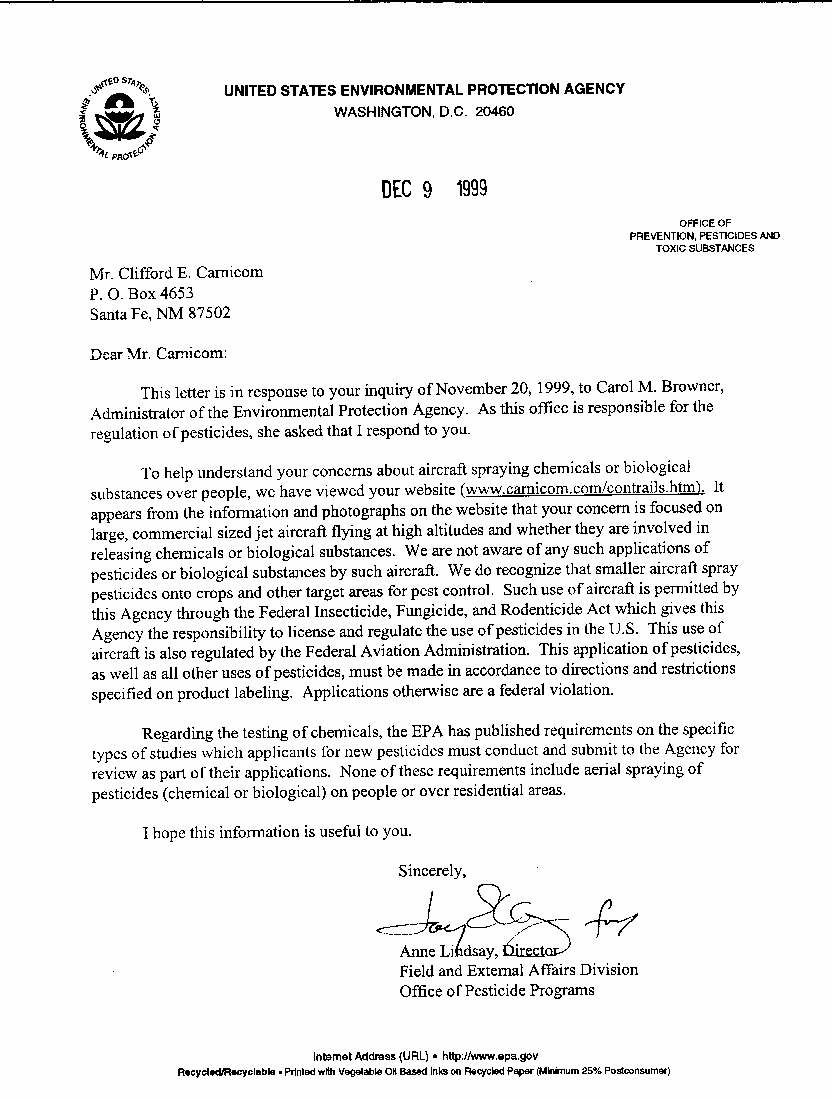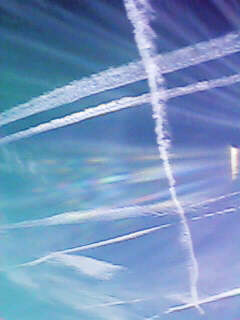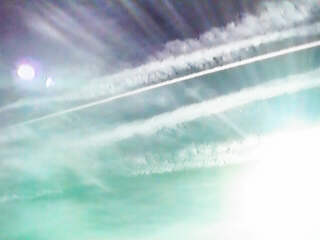
REPRESENTATIVE UDALL FAILS TO RESPOND
A comprehensive briefing package on the aerosol issue containing photographs, testimonies, research references and petitions for congressional action on this issue was hand delivered by a prominent media person to Congressional Representative Thomas Udall of New Mexico on September 2, 1999. After no response for evaluation was received back by late November 1999, second and third letters were sent asking for a reply from Representative Udall. Mr. Udall finally sent a form letter back in March of 2000 to the deliverer of the material, stating that he had made a request for Congress to hold hearings on this matter. A spokesman for Representative Udall later stated no such request had been made to Congress by Representative Udall.

WORLD NET DAILY ‘PASSES’ FOR THE TIME BEING
Notice has been received on 01-13-00 that the World Net Daily, a leading internet newspaper, will be 'passing' on the presentation of an article on the aerosol issue. Two days prior to this announcement, an impending article on the aerosol issue was indicated by this same newspaper. No specific reason for the cancellation or postponement of the article was stated, other than that the issue had been forwarded to higher editorial management.

ABC NEWS 20/20 SAYS ‘UNFORTUNATELY’ IT WAS NOT CHOSEN
ABC NEWS 20/20 SAYS 'UNFORTUNATELY'
IT WAS NOT CHOSEN

AN OPEN INVITATION
An open invitation is posted on www.carnicominstitute.org on this date that challenges anyone who refutes the veracity of evidence presented and analyzed on this website to contact the institute and set up a meeting of minds for a discussion on proof present in the Carnicom papers. “This invitation is open to ANYONE with doubt of the evidence presented”.

UNITED STATES EPA IS ‘NOT AWARE’ OF ‘SUCH APPLICATIONS’ BY ‘SUCH AIRCRAFT’
Postscript note by Clifford E Carnicom:
One would logically conclude that the EPA, having viewed the evidence submitted on www.carnicom.com, IS now quite aware of "such applications" by "such aircraft."

SANTA FE NM NOV 30 1999, SOUTHERN SKY 0945
Pictures captured and posted in this paper show massive aerosol trails sprayed in criss-cross patterns in Santa Fe, New Mexico on November 3, 1999.

OHIO ENVIRONMENTAL PROTECTION AGENCY DECLARES THAT IT IS ‘UNABLE’ TO COMPLETE AN INVESTIGATION
OHIO ENVIRONMENTAL PROTECTION AGENCY DECLARES THAT IT IS 'UNABLE' TO COMPLETE AN INVESTIGATION
This letter was recently received by a Ohio citizen:

‘MEGASPRAYER’ NUMBER 4 CAPTURED
This set of photos shows aerosol emissions extending across the entire wingspan of a McDonnell Douglas MD80 aircraft on November 30, 1999 in Santa Fe, New Mexico . This aircraft has rear mounted engines, showing that this wide span of aerosols cannot be emanating from the engines alone. These pictures show the same entire wingspan results that have been witnessed in previous Carnicom papers named THIRD ‘MEGASPRAYER’ CAPTURED (September 9, 1999), NEW CHEMTRAIL SPRAY SYSTEM REVEALED (August 14, 1999), and NEW CHEMTRAIL SPRAY SYSTEM CONFIRMED (August 14, 1999).

NM ATTORNEY GENERAL OFFICE SUBSTANTIATES THAT ACTIVITY IS ‘NORMAL’
NM ATTORNEY GENERAL OFFICE SUBSTANTIATES THAT ACTIVITY IS 'NORMAL'

UNIVERSITY OF MICHIGAN CLASSIFIES INQUIRY AS ‘HARASSMENT’
University of Michigan Correspondence with Individual Seeking Information on Nano Technology Research Program:
TIME LINE OVERVIEW: 1. Letter to Dr. Jones - DARPA - Nov. 15th from A. C. Griffith. 2. Reply from the Director of DARPA, Lawrence H. Dubois, Nov. 16th to A.C. Griffith. 3. A.C.Griffith made one telephone call and one e-mail to Univ. of Mich., News and Information Service, Ann Arbor, Michigan, Nov. 17th. 4. E-mail to A.C. Griffith received from Officer Sura on computer in Winston-Salem. 5. Telephone message to A.C. Griffith on answering machine in Richmond from Officer Sura, University of Michigan, sometime between Nov. 19 and Nov. 21, 1999. 6. Reply letter to Officer Sura dated Nov. 22, 1999.

NATIONAL PROTEST NOV 20 SANTA FE “OFFICIAL RESPONSE”
In this paper, pictures captured and posted by Clifford Carnicom in the southern sky of Santa Fe, New Mexico on November 20, 1999, show massive trails sprayed in various patterns at different altitudes and spreading out into persistent trails.

